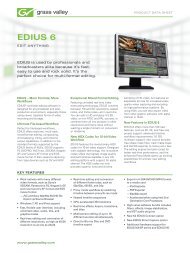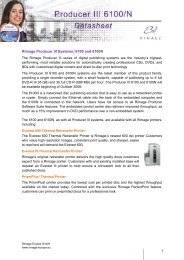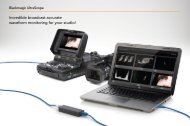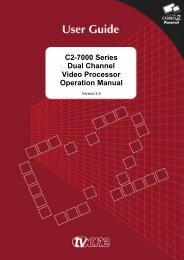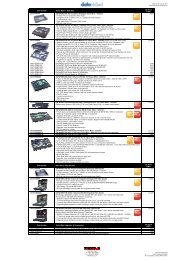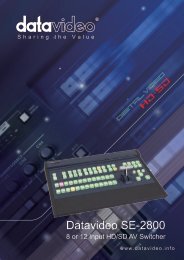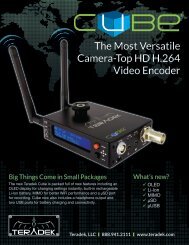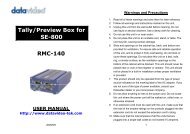ATEM Switchers Manual - Holdan.eu
ATEM Switchers Manual - Holdan.eu
ATEM Switchers Manual - Holdan.eu
Create successful ePaper yourself
Turn your PDF publications into a flip-book with our unique Google optimized e-Paper software.
53<br />
Using the <strong>ATEM</strong> 2 M/E Broadcast Panel<br />
ON ON ON ON<br />
BKGD KEY 1 KEY 2 KEY 3 KEY 4<br />
FTB<br />
Transition Style Buttons<br />
The transition type buttons allow the operator to select one of five types of transitions; mix, wipe, dip, DVE,<br />
and stinger. Mix, wipe, stinger and DVE transition types are selected by pressing the appropriately labeled<br />
transition type button which will illuminate yellow.<br />
DIP<br />
MIX<br />
WIPE STNG DVE<br />
M/E 2<br />
PATT<br />
M/E 2<br />
KEY<br />
BOX 4<br />
BOX 2<br />
The Dip transition type is selected by holding down the SHIFT button while pressing the MIX/DIP transition<br />
type button, or by double-pressing the MIX/DIP button. The button will illuminate green indicating a shifted<br />
transition type.<br />
DSK<br />
KEYS<br />
M/E 2<br />
PATT<br />
COLOR<br />
M/E 1<br />
PATT<br />
M/E 2<br />
KEY<br />
M/E 1<br />
KEY<br />
BOX 4<br />
BOX 2<br />
BOX 4<br />
BOX 2<br />
PREV<br />
TRANS<br />
CUT<br />
AUTO<br />
M/E 1<br />
PATT<br />
M/E 1<br />
KEY<br />
BOX 4<br />
BOX 2<br />
PREV TRANS<br />
The PREV TRANS button enables the preview transition mode allowing the operator to verify a dip, mix,<br />
wipe or DVE transition by performing it on the preview output using the fader bar. Once you press this<br />
button on, you can preview your transition as many times as you like allowing you to make changes and<br />
corrections as needed. You can even preview stinger transitions! Once you are happy with the preview<br />
1 2 3<br />
transtion, press the button off and and you are now ready to send your transtion on air.<br />
ON ON<br />
KEY 3 KEY 4<br />
Transition Control and<br />
Upstream Keyers<br />
FTB<br />
1<br />
2 3<br />
4 5 6<br />
7<br />
8 9<br />
4 5 6<br />
Next Transition<br />
7 8 9<br />
The BKGD, KEY 1, KEY 2, KEY 3, KEY 4 buttons are used to select the elements which will transition on air or<br />
CAM 0 CLR<br />
off air with the next transition. Any combination of background and keys can be selected by pressing multiple<br />
buttons simultaneously. Double-pressing the BKGD button selects all of the next transition upstream keyers<br />
that are currently on air and copies them to the Next Transition buttons.<br />
DVE<br />
AUTO<br />
CAM<br />
DSK 1<br />
TIE<br />
DSK 1<br />
CUT<br />
0 CLR<br />
DSK 2<br />
TIE<br />
DSK 2<br />
CUT<br />
TRANS<br />
AUX<br />
PANEL<br />
SETUP<br />
EFFECTS<br />
KEYS<br />
MEDIA<br />
PLAYER<br />
DSK<br />
KEYS<br />
COLOR<br />
Pressing DSK 1 any DSK 2 of the next transition buttons will clear selection of all others. When selecting the elements of<br />
TIE<br />
TIE<br />
the next transition, the switcher operator should look at the preview output because it provides an accurate<br />
representation of what the program output will look like after the transition is completed. When only the<br />
BKGD button is selected, a transition from the current source on the program bus to the source selected on<br />
the preview bus will occur.<br />
DSK 1<br />
CUT<br />
DSK 2<br />
CUT<br />
ON AIR<br />
DSK 1<br />
DSK 2<br />
The AUTO ON AIR AUTO indicator buttons indicate which of the upstream keys are currently on air and can also be used<br />
to immediately cut a key on or off air.<br />
DSK 1<br />
AUTO<br />
DSK 2<br />
AUTO<br />
Downstream Keyers and<br />
Fade to Black<br />
Downstream Keyers<br />
DSK TIE<br />
The DSK TIE button will enable the DSK on the preview output, along with the next transition effects, and tie<br />
it to the main transition control so that the DSK can be taken to air with the next transition.<br />
Because the tied downstream keyer is now tied to the main transition, the transition will happen at the rate<br />
specified in the transition rate display of the transition control block. When the DSK is tied, the signal routing<br />
to the clean feed 1 is unaffected.




